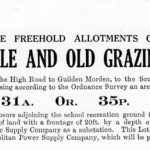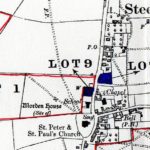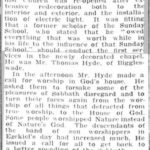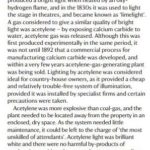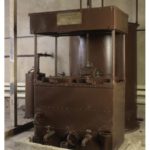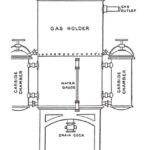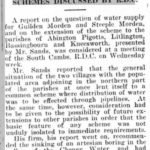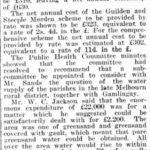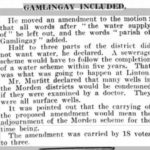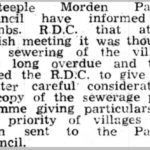Utilities
Water
A piped supply was discussed by the South Cambridgeshire Rural District Council in 1935 and a newspaper report is below. An artesian well in the Cheyney Water valley, where Bogs Gap joined Abington Road was envisaged, with a reservoir near Cheyney Lodge.
Piped water arrived in the village in 1936, initially in the centre and gradually the network was extended. Prior to that water was drawn from wells, ponds and watercourses, such as Cheyney Water.
Electricity
Heat would have been provided by burning wood and later coal, after the arrival of the Railway in 1850. Light was from oil lamps and candles.
On 22 July 1933 John Jarman owner of Church and Moco Farms sold a plot of land 20ft by 40ft in Hay Street to the North Metropolitan Power Supply Company to site an electrical sub-station. On 8 September 1935 the Methodist Chapel, re-opened after a refurbishment, which included notably the installation of electric light. The two facts suggest electricity arrived in the village in 1933/4. In the Women’s Institute Scrapbook created in 1958, it is suggested that electricity came in 1936, which appears to be out by a couple of years.
Gas
Steeple Morden has never had a gas supply. In the early days of gas, some larger villages built their own gas works, but this did not happen in Steeple.
In 1929 The Priory in Church Street had its own Acetylene Gas Plant to provide gas for lighting. There is background information below.
Refuse Collection
This began after the Second World War, initially collections were every other month and then in the 1950s became every month, until eventually it became weekly. Large metal dustbins were used, until the advent of black plastic sacks, and everything went to landfill. There was a great shake-up of rubbish handling in the late 1990s and recycling became the focus and the black sacks were replaced by colour coded plastic bins – black = rubbish, blue = recycling and green = organic waste – emptied initially weekly and then on an alternate week cycle.
Prior to the refuse collection service most rubbish was burnt or buried, as one may discover when digging today in the corner of an old garden.
Mains Drainage
In the past, potties or outside toilets were usually the norm in rural areas and disposal arrangements were down to individual householders. From the 1860s flush toilets began to be installed served by cesspits or septic tanks. Those residents with simple outside toilets, not connected to any disposal system, might have to rely on the night soil men for the removal of waste; a service eventually provided by the local authority and continued into the 1960s. They called weekly to empty buckets into their road tanker.
The Parish Council was pressing the District Council for mains drainage as early as 1954, but were told to wait their turn, as the newspaper clip below shows.
The traditional arrangements were not replaced by main drainage until 1964-66, after planning approval was granted on 2 October 1964 for the construction of a sewage treatment works on a three acre site off Potton Road, Guilden Morden, which was designed to serve both parishes. The mains drainage was installed to serve the village or central part of the parish and properties outside the village envelope still have their own septic tank or waste systems.
Click on image to view. Click again to enlarge. Drag to view entire image.
Sale Particulars, Newspapers and Background Information
Last Updated on June 5, 2022

